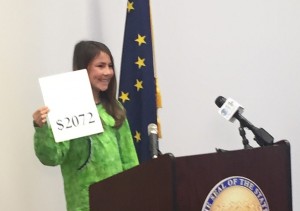
ANCHORAGE – Governor Bill Walker and Lt. Governor Byron Mallott today underscored the importance of a stable fiscal future for future generations of Alaskans, as they broke from tradition in announcing the amount of individual Alaskans’ permanent fund dividend check. Shania Sommer, a seventh-grader from Palmer Junior Middle School, announced the exact amount of the check. Shania is a 12-year-old student enrolled in the Alaska Native Science and Engineering Program.
“A month ago, I asked Shania to participate in this historic announcement because I want to send a message,” Governor Bill Walker said. “This is the largest permanent fund dividend payout in Alaska history. We are paying out more in PFD checks than we are for the education of young Alaskans like Shania—at a time when we are struggling with a $3.5 billion deficit. Alaskans need to know this is unsustainable. I’m confident Alaskans will pull together to find a solution, as we always do when times are tough.”
“For the past two summers, I participated in the Alaska Native Science and Engineering Middle School Academy,” said Shania Sommer. “ANSEP has gotten me even more interested in school, and my career goals are to become a civil engineer or an Alaska State Trooper. I have been saving my Alaska Permanent Fund Dividend to help pay for my college education, so I am excited to help reveal the amount of the 2015 PFD.”
Beginning October 1, more than 644,000 Alaskans will each receive $2,072, the largest PFD payout in state history. The State of Alaska will pay $1.33 billion in PFD checks, which exceeds the $1.3 billion spent for education this year.
“From the very beginning, almost all who supported and those who created and shaped the Permanent Fund believed that the Fund’s basic purpose was to help replace one-time oil wealth with renewable and growing financial wealth to meet state needs,” said Lt. Governor Mallott, who served as a Permanent Fund Corporation trustee (1982 – 1990) and executive director (1995 – 2000).
Also on hand for the announcement was Eric Wohlforth, former Department of Revenue Commissioner (1970 – 1972) and one of the longest serving member of the Alaska Permanent Fund Corporation Board of Trustees (1995 – 2006).
“The original purpose of the Permanent Fund was to save wealth for future generations of Alaskans,” said Eric Wohlforth. “This is the people’s fund. In the months before the legislative session, groups will meet to talk about how we should manage our wealth. I urge all Alaskans to become informed investors, for their sake and for the sake of the next generation.”
To date, the Alaska Permanent Fund is worth over $51..4 billion. Since 1982, just over $23.3 billion has been distributed to Alaskans through PFD checks. Governor Walker noted the irony of this year’s large dividend payout at a time when the state is facing its largest budget gap ever.
“Across Alaska, we are laying off school teachers, cutting trooper posts, and scaling back services provided by the state,” said Governor Walker. “It is time to have an open and honest conversation about our finances, and how resources like the Permanent Fund can be used as an asset. The vision of the Permanent Fund was to turn a nonrenewable resource into a renewable one, and it is our job to determine how to best use and protect that gift for the benefit of all Alaskans.”
Established in 1976 by constitutional amendment, the Alaska Permanent Fund sets aside at least 25 percent of all the state’s mineral royalties and lease payments, and is invested as an income-producing asset for the state—which is set aside in an earnings reserve account. Each year, a dividend is distributed from that account based on the average income of the fund over the previous five years. Income in the earnings reserve account is also available for legislative appropriation.
“We are fortunate that our predecessors had the foresight and wisdom to set aside Alaska’s oil wealth for the benefit of future generations,” Lt. Governor Mallott said. “It is now our responsibility to apply that same wisdom to the financial decisions we face today so our children and grandchildren can also live in a prosperous Alaska.”
[smoothcategory catg_slug=”state”]
